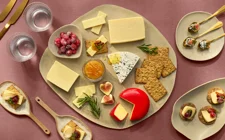
Gorgonzola (PDO)
What is Gorgonzola (PDO)?
Lush plains stretching beside knitted rivers and lakes dominate the landscape surrounding Gorgonzola. A province bound in Italian cuisine, it is home to its namesake: Gorgonzola cheese. Resembling archaic porcelain, this blue mould cheese spares little in the way of decadence and flavor. When young, it is soft and creamy, opening with nimble strokes of butter and slowly approaching a slightly acidic finish. Mature versions are stronger, piquant and deliver a pungent bite to finish.
On pastures spread across the regions of Lombardy and Piedmont, cows feed on natural forage, delivering unrestricted, full-bodied milk to the creameries. Originally thought to derive from the herded cows being exhausted, the unique flavors of Gorgonzola are still attributed to these regions.
With a distinct look, Gorgonzola is versatile in its uses, adding zest to risottos, pastas or pizzas. The white and blue marbling stands gracefully on a cheese board, pairing wonderfully with grapes, honey and pistachios.
Often referred to as blue cheese, Gorgonzola is exclusively made from cow’s milk, often boasting milder flavors than those of other blue cheeses.
How Gorgonzola (PDO) is made*
With a history shrouded in mystery, today Gorgonzola is still made with passion and feeling - a hallmark of Italian cuisine.
Fresh milk from nearby pastures is delivered daily to the local creameries. Rigorous monitoring confirms the quality of the milk, ensuring it maintains its full-bodied flavors after pasteurization. A mixture of carefully selected yeasts and rennet is added to the pasteurized milk, which is then transferred to large tanks, with the purpose of coagulating the milk and triggering the marbling effect. Shortly after this, the milk curdles to a firm paste. The curd is then cut and separated, allowing the whey to be released. Placed in molds and brined with sea salt, the molds are placed to age. During this process, the rind is pierced with steel needles, promoting the marbling within the body. After a minimum of 50 days spent maturing, the cheese is labelled Gorgonzola.
*Castello does not produce or sell Gorgonzola (PDO).
Pick another Blue Mould Cheese
If you appreciate the qualities of Grogonzola there are other cheeses you might enjoy.
Creamy Blue is gentle, rich, and smooth, with tones of mild bitterness followed by a soothing finish. It starts softly and gradually reveals its slightly sharp profile, offering a delightful blend of zest and creaminess.
Roquefort (PDO), made from sheep’s milk, is known for its tangy and crumbly texture, with unique marbling that adds to its aromatic and pungent character.
Blue Stilton (PDO) is a crumbly blue mold cheese that is strong in taste and aroma, providing depth and a tangy finish.
Curious about the world of cheese? Here's everything you need to know about how to store, serve and cut cheese!











